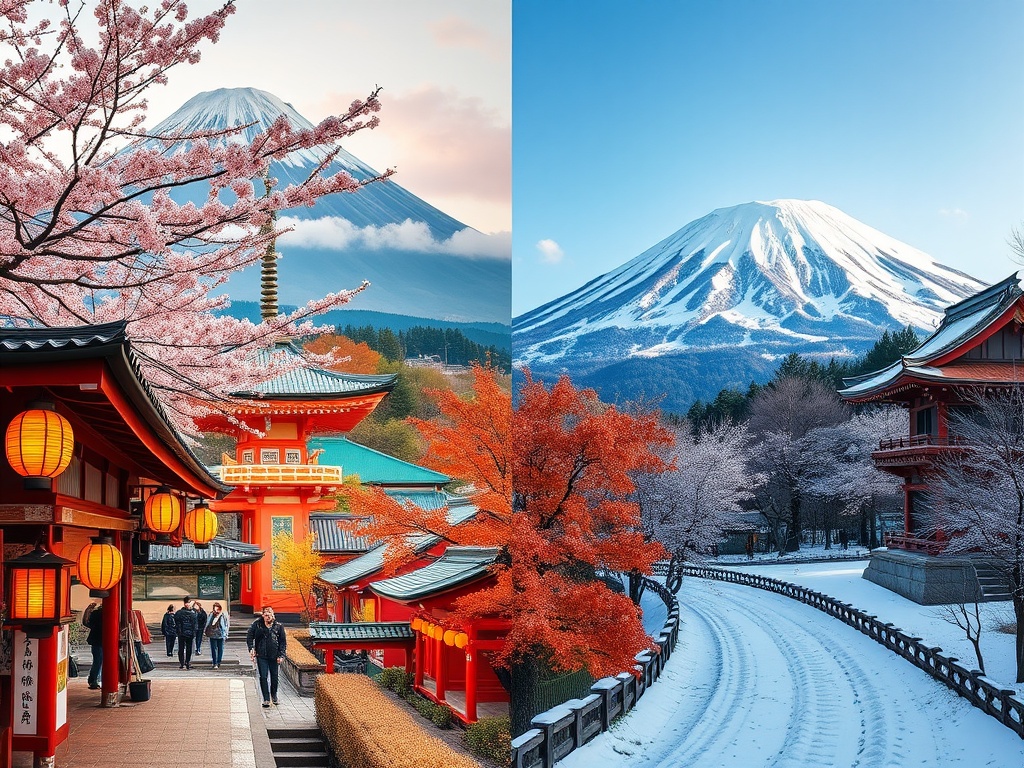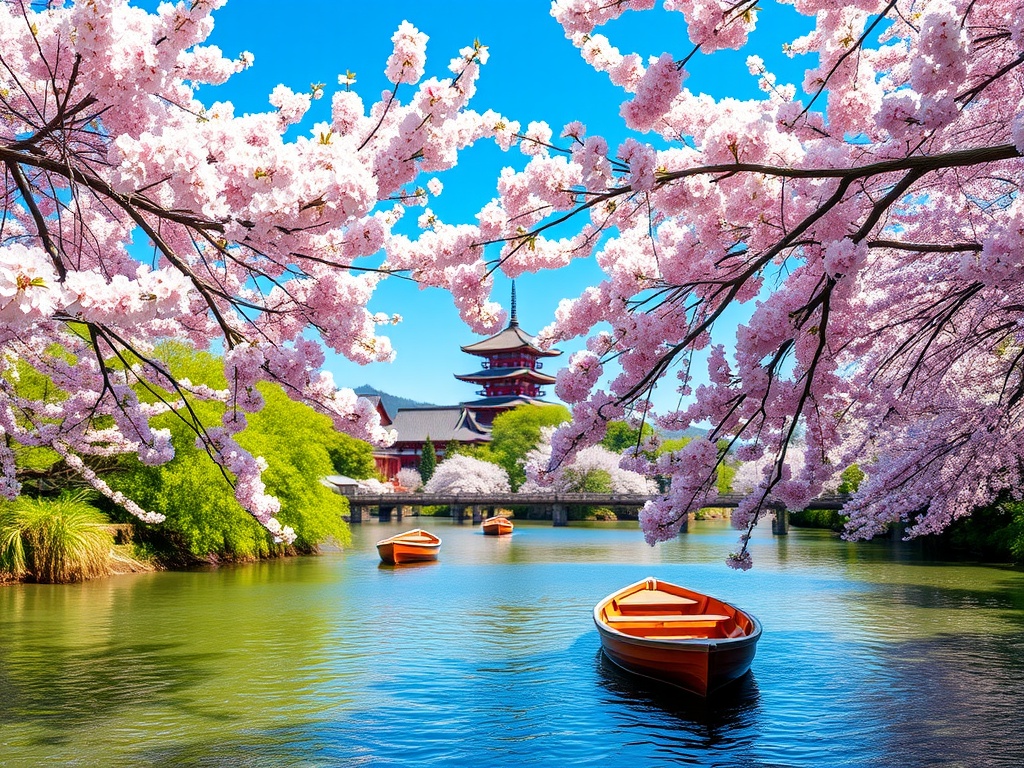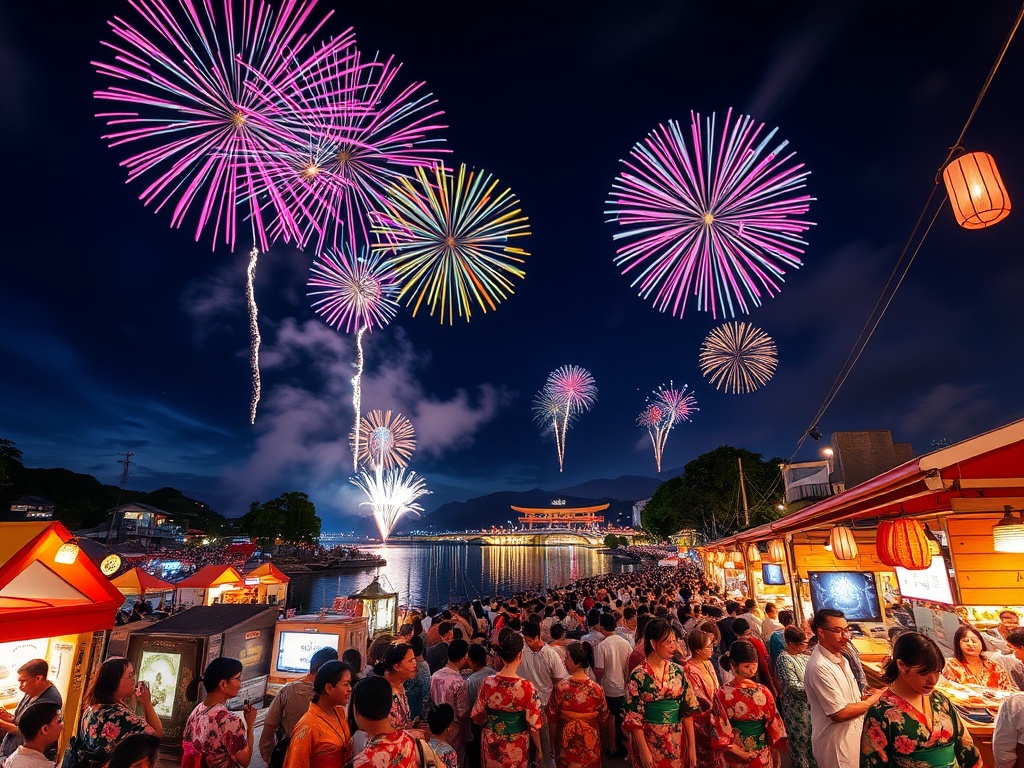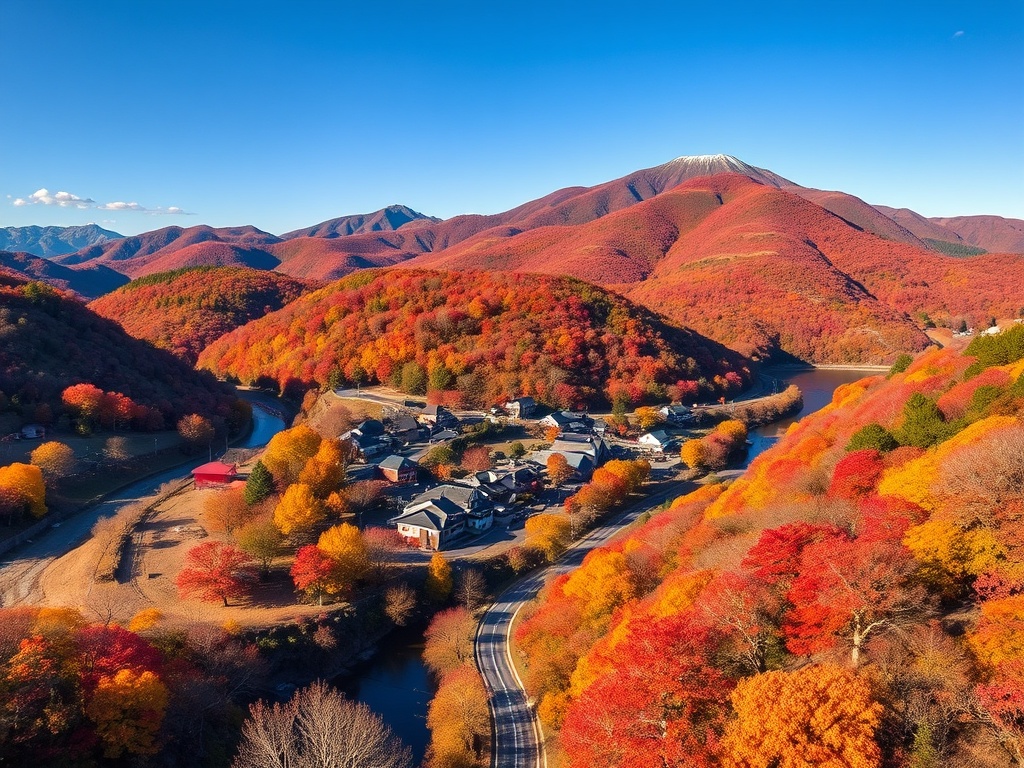Cherry Blossoms & Beyond: Springtime Splendor in Japan
Win a Free Trip to Japan!
Experience cherry blossoms and ancient temples
Springtime in Japan is nothing short of magical. As the chill of winter gives way to warmer days, the entire nation transforms into a canvas of pink and white hues, thanks to the cherry blossoms, or sakura. But the allure of Japan in spring extends beyond the fleeting beauty of its blossoms. From traditional festivals to serene landscapes, there’s a kaleidoscope of experiences waiting for you.
The cherry blossom season is undoubtedly the highlight of spring in Japan. Starting from the southern islands and sweeping northwards, the sakura bloom at different times across the country. Here’s a look at some prime locations and their typical blooming periods:
| Location | Typical Blooming Period |
|---|---|
| Tokyo | Late March – Early April |
| Kyoto | Late March – Early April |
| Hokkaido | Late April – Early May |
Spring in Japan is not just about admiring the cherry blossoms; it’s also a time of celebration. The country comes alive with a variety of festivals that offer a glimpse into its rich cultural heritage. Here’s a quick overview of must-see events:
- Hanami Parties: Join locals enjoying picnics under blooming cherry trees, a tradition dating back centuries.
- Takayama Spring Festival: Held in April, this festival features ornate floats and lively processions in the historic town of Takayama.
- Kanamara Matsuri: Known as the ‘Festival of the Steel Phallus,’ this unique event in Kawasaki is both quirky and fascinating.
While the sakura undoubtedly steal the spotlight, Japan’s spring landscapes offer so much more. Verdant mountains, serene gardens, and vibrant azaleas all contribute to the season’s charm. Don’t miss the following:
- Mount Yoshino: Known for its thousands of cherry trees blooming in stages, providing a prolonged viewing period.
- Kenrokuen Garden: Located in Kanazawa, this garden is one of Japan’s most beautiful, featuring seasonal flowers and tranquil ponds.
- Fuji Shibazakura Festival: Marvel at fields carpeted with pink moss phlox with Mount Fuji as a backdrop.
Summer Festivals & Fireworks: Embracing Japan’s Vibrant Heat
Summer in Japan is a season where the country truly comes alive with energy, color, and a palpable sense of excitement. As the temperatures rise, so does the spirit of celebration, making it an ideal time for travel and tourism enthusiasts to immerse themselves in Japan’s vibrant culture. From the enchanting glow of fireworks lighting up the night sky to the rhythmic beats of traditional festival music, summer in Japan offers an unforgettable experience that goes beyond the ordinary.
The heart of Japan’s summer lies in its matsuri or festivals, which are celebrated with great enthusiasm across the country. These festivals are not only a feast for the senses but also a deep dive into Japan’s rich cultural tapestry. Each region has its own unique festival, offering a distinct flavor and tradition. The Gion Matsuri in Kyoto is one of the most famous, showcasing vibrant floats and traditional kimonos. Meanwhile, the Tanabata festival in Sendai transforms the city with colorful streamers and decorations, celebrating the annual meeting of the star-crossed lovers, Orihime and Hikoboshi.
As the sun sets, Japan’s night skies come alive with spectacular hanabi taikai or fireworks displays. These events are a highlight of the summer season, where both locals and tourists gather to watch the skies burst with color and patterns. The Sumida River Fireworks Festival in Tokyo is a must-see, with its dazzling display over the iconic river attracting millions each year. Similarly, the Omagari Fireworks in Akita is a competitive event where pyrotechnicians showcase their most creative and breathtaking designs. These festivals are not just about the fireworks; they also offer food stalls, traditional games, and a chance to wear a yukata, enhancing the overall experience.
Autumn Adventures: A Tapestry of Colors Across Japan
As summer’s vibrant energy gently fades, Japan transforms into a mesmerizing canvas of fiery reds, glowing oranges, and golden yellows. Autumn in Japan offers travelers an enchanting experience, where the natural landscapes are adorned with breathtaking colors, and the crisp air invites exploration. This season, known as koyo, is as cherished as the cherry blossoms of spring, drawing visitors to witness the kaleidoscope of hues that sweep across the nation. From serene temples nestled in wooded hills to bustling cities framed by colorful foliage, autumn is an ideal time to immerse yourself in Japan’s cultural and natural beauty.
The phenomenon of koyo begins in the northern regions, gradually moving southward, much like the cherry blossoms. One of the most renowned spots for leaf-peeping is Nikko, where the vibrant leaves contrast beautifully against the backdrop of ancient shrines and the serene waters of Lake Chuzenji. In Kyoto, the historic temples like Kiyomizu-dera and Tofuku-ji offer stunning vistas of autumn foliage, providing a picturesque setting for reflection and admiration. Meanwhile, the majestic Mount Takao near Tokyo offers hiking trails that reward adventurers with panoramic views of the city amidst the dramatic colors of fall.
Autumn is not only a visual delight but also a time to indulge in Japan’s rich cultural tapestry. The season is marked by harvest festivals, where locals gather to give thanks for a bountiful year. The lively Jidai Matsuri in Kyoto is a grand procession celebrating the city’s illustrious history, featuring participants dressed in historical attire. Additionally, the Nagasaki Kunchi festival showcases vibrant parades and traditional dance performances, reflecting the unique blend of Japanese and foreign influences.
Beyond the festivals, autumn is a time to savor seasonal delicacies. The markets brim with an array of flavors, from the sweet aroma of roasted chestnuts to the exquisite taste of matsutake mushrooms. Visiting Japan in autumn ensures a feast for both the eyes and the palate, as you savor the culinary delights that the season brings.
Winter Wonderlands: Japan’s Snowy Escapes and Hot Springs Bliss
As the vibrant hues of autumn fade, Japan transforms into a winter wonderland, offering unique experiences that captivate travel and tourism enthusiasts. The chilly embrace of winter unveils a different side of Japan, where snow-capped mountains and steaming hot springs create a serene yet thrilling atmosphere. From the iconic ski resorts of Hokkaido to the tranquil onsen towns, winter in Japan is a magical time that combines adventure with relaxation.
Japan’s winter allure is epitomized by its world-renowned ski resorts, which beckon adventurers with their powdery slopes and breathtaking landscapes. Niseko, nestled in the northern island of Hokkaido, is a paradise for ski and snowboard enthusiasts, offering an abundance of fresh powder snow and a vibrant après-ski scene. The region’s unique climate ensures consistent snowfall, making it a prime destination for winter sports. Meanwhile, the Japanese Alps boast picturesque resorts like Hakuba, where visitors can enjoy a myriad of winter activities amidst stunning alpine views. Beyond skiing, Japan’s snow festivals, such as the Sapporo Snow Festival, showcase incredible ice sculptures and illuminate the winter nights with their enchanting beauty.
After a day spent on the slopes, there’s nothing quite like unwinding in one of Japan’s natural hot springs, or onsens. These geothermal wonders provide the perfect escape, offering a blissful retreat from the winter chill. Beppu, located on the island of Kyushu, is famed for its diverse range of hot springs, each offering unique therapeutic benefits. The tranquil atmosphere of onsen towns like Kusatsu and Gero invites visitors to soak in the mineral-rich waters, surrounded by snow-dusted landscapes. The experience transcends mere relaxation; it’s a cultural journey into Japan’s deep-rooted tradition of bathing, where the mind and body find harmony.
Cultural Extravaganza: Dive into Japan’s Rich Traditions Year-Round
Japan is a land where tradition and modernity dance gracefully in the rhythm of the seasons. Each time of year unveils a unique aspect of Japanese culture, inviting travelers to delve deeper into its timeless customs and contemporary innovations. Whether you’re strolling through a serene temple garden, participating in a lively festival, or savoring the country’s exquisite cuisine, Japan’s cultural offerings are as diverse as they are captivating.
Throughout the year, Japan hosts a plethora of festivals and rituals that reflect its rich history and dynamic culture. In the spring, the air is filled with excitement as Hanami parties bring people together to appreciate the fleeting beauty of cherry blossoms. As summer unfolds, the streets come alive with the vibrant energy of matsuri, where locals and visitors alike can enjoy traditional dances, parades, and the enchanting glow of fireworks. Autumn offers a more subdued yet equally engaging experience, with harvest festivals that honor the abundance of the season and give thanks to the land.
Winter, on the other hand, invites introspection and warmth. As the snow blankets the landscape, the Japanese engage in new year celebrations that combine solemn rituals with joyful gatherings. It’s a time to reflect, renew, and rejoice, as families come together to share meals and partake in age-old customs, setting intentions for the year ahead.
Japan’s dedication to craftsmanship is evident in its artisanal traditions, which are celebrated throughout the year. Each region prides itself on its unique crafts, from the delicate art of porcelain in Arita to the intricate weaving of Nishijin silk in Kyoto. Visitors can immerse themselves in these traditions by participating in workshops that offer a hands-on experience of Japanese artistry. These creative encounters not only illuminate the meticulous skill involved but also provide a deeper appreciation for the cultural significance behind each craft.
The country’s culinary artistry is equally noteworthy. Each season brings with it a distinct array of flavors, showcasing the Japanese commitment to using fresh, seasonal ingredients. From the rich, comforting dishes of winter to the light, refreshing meals of summer, Japan’s cuisine is a testament to its cultural diversity and culinary excellence.
Off-Peak Perks: Discover Japan’s Hidden Gems Away from the Crowds
For those seeking an escape from the bustling crowds and a chance to explore Japan’s more tranquil side, visiting during the off-peak seasons unveils a treasure trove of hidden gems. While the allure of cherry blossoms in spring and fiery autumn foliage often draws throngs of tourists, the quieter months offer a unique opportunity to experience the country’s authentic charm. Whether you are a seasoned traveler or a curious explorer, discovering Japan away from the typical tourist trail can be an enriching experience.
Amidst Japan’s urban hustle, off-peak travel allows you to find solace in its serene temples and lush gardens without the usual crowds. Kamakura, a coastal town south of Tokyo, offers a peaceful retreat with its array of ancient temples nestled in verdant hills. Here, you can wander the grounds of Hase-dera and admire its beautiful hydrangea path in a serene environment. Similarly, the Ritsurin Garden in Takamatsu, renowned for its meticulously landscaped beauty, provides a perfect backdrop for tranquil reflection. Visiting these sites during quieter months ensures a more personal and introspective experience, allowing you to connect deeply with Japan’s spiritual heritage.
Japan’s natural landscapes are as diverse as they are breathtaking, and venturing off the beaten path reveals an array of stunning vistas. The Okinawa Islands, often basking in gentle climates, offer pristine beaches and crystal-clear waters year-round, perfect for a secluded escape. Meanwhile, the rugged beauty of Shikoku’s Iya Valley presents dramatic mountain views and rustic vine bridges that beckon adventurers. These less-trodden trails promise an intimate connection with nature, offering a sense of discovery and awe that is often missed in more popular destinations.
Choosing to explore Japan during off-peak times not only grants a reprieve from the usual tourist surge but also invites a deeper appreciation of its cultural and natural splendors. Whether you are drawn to the spiritual tranquility of hidden temples or the untouched beauty of remote landscapes, Japan’s off-peak gems promise a journey of discovery and delight.



